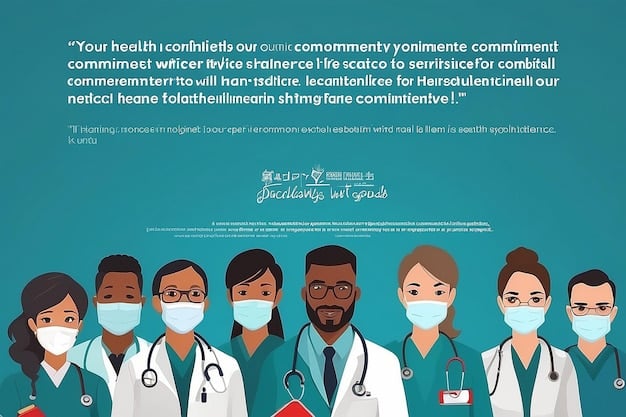Understanding Essential Health Benefits Under the Affordable Care Act

Understanding the Affordable Care Act’s Essential Health Benefits: A Comprehensive Guide provides a detailed overview of the ten categories of services that most health insurance plans must cover under the ACA, ensuring accessible and comprehensive healthcare for Americans.
Navigating the complexities of healthcare can be challenging, especially when understanding the Affordable Care Act (ACA) and its provisions. One of the most crucial aspects of the ACA is its mandate for **understanding the Affordable Care Act’s Essential Health Benefits: A Comprehensive Guide**, ensuring everyone has access to a core set of healthcare services.
What are Essential Health Benefits?
Essential Health Benefits (EHBs) are a set of ten categories of services that the Affordable Care Act requires most health insurance plans to cover. Understanding these benefits is critical for anyone seeking health insurance in the United States, as they ensure a baseline level of coverage regardless of the plan you choose.
These benefits were designed to make healthcare more accessible and equitable. Let’s delve deeper into what each of these categories includes and why they are essential.
Categories of Essential Health Benefits
The ACA outlines ten specific categories that constitute essential health benefits. These categories cover a wide range of medical and healthcare services.
- Preventive and Wellness Services
- Ambulatory Patient Services
- Emergency Services
- Hospitalization
- Mental Health and Substance Use Disorder Services
- Prescription Drugs
- Laboratory Services
- Pediatric Services, including oral and vision care
- Pregnancy, Maternity, and Newborn Care
- Rehabilitative and Habilitative Services and Devices
Each of these categories plays a vital role in ensuring comprehensive healthcare coverage for individuals and families. We will explore each category in detail in the following sections.

In conclusion, understanding what constitutes essential health benefits is the first step in ensuring that you have comprehensive healthcare coverage under the ACA. Knowledge of these categories helps you make informed decisions when selecting a health insurance plan.
Preventive and Wellness Services
Preventive and wellness services are a cornerstone of the ACA’s essential health benefits, focusing on proactive healthcare measures. These services aim to prevent illnesses before they occur and promote overall well-being.
These services often include routine check-ups, vaccinations, and screenings that can detect potential health issues early on.
Examples of Preventive Services
Preventive services cover a wide array of healthcare offerings designed to keep you healthy and detect potential problems early.
- Vaccinations: Protection against infectious diseases like influenza, measles, and tetanus.
- Screenings: Early detection of conditions such as cancer, diabetes, and high blood pressure.
- Well-woman Visits: Comprehensive care for women, including pap smears and mammograms.
- Routine Check-ups: Regular visits to monitor overall health and identify potential concerns.
Preventive services are often covered at no additional cost to the patient, as they are considered essential for maintaining public health. This helps encourage individuals to seek necessary care without financial barriers.
In summary, preventive and wellness services are fundamental to maintaining good health. By utilizing these services, individuals can proactively manage their healthcare and reduce the risk of developing chronic conditions.
Ambulatory Patient Services
Ambulatory patient services refer to medical care provided on an outpatient basis, meaning you don’t need to be admitted to a hospital. These services are crucial for addressing a wide range of health needs without the need for overnight stays.
This category encompasses various medical settings, including doctors’ offices, clinics, and urgent care centers.
Types of Ambulatory Care
Ambulatory patient services cover a broad spectrum of medical treatments and consultations.
- Doctor’s Visits: Routine check-ups, consultations, and follow-up appointments.
- Outpatient Surgery: Surgical procedures that do not require hospitalization.
- Diagnostic Testing: Imaging and laboratory tests performed outside of a hospital setting.
- Therapy Services: Physical, occupational, and speech therapy for various conditions.
Ambulatory care is designed to be convenient and accessible, allowing patients to receive necessary medical attention without disrupting their daily lives. The ACA ensures that these services are part of the essential health benefits.
In conclusion, ambulatory patient services are a critical component of comprehensive healthcare. They provide accessible and convenient medical care for a wide range of health needs, ensuring individuals receive the attention they require without hospitalization.
Emergency Services
Emergency services are crucial for addressing sudden and severe medical conditions that require immediate attention. The ACA ensures that health insurance plans cover emergency care, regardless of whether the hospital is in your plan’s network.
This provision aims to protect individuals from unexpected medical bills when seeking emergency treatment.
What Constitutes an Emergency?
Emergency services cover medical conditions that pose an immediate threat to your health or life.
- Severe Pain: Intense pain that requires immediate medical intervention.
- Difficulty Breathing: Respiratory distress that can be life-threatening.
- Chest Pain: A potential sign of a heart attack or other serious cardiac condition.
- Sudden Injury: Traumatic injuries that require immediate medical attention.

The ACA mandates that insurance plans cover emergency services without prior authorization, ensuring that individuals can seek necessary care without delay. This provision protects individuals from financial penalties for seeking emergency treatment at out-of-network facilities.
In summary, emergency services are a vital component of the ACA’s essential health benefits, providing a safety net for individuals facing sudden and severe medical conditions. The guarantee of coverage, regardless of network status, ensures access to timely and life-saving medical care.
Hospitalization
Hospitalization refers to inpatient care received in a hospital setting, typically involving an overnight stay. This category of essential health benefits covers a wide range of medical conditions that require intensive treatment and monitoring.
The ACA ensures that health insurance plans cover hospitalization services, including room and board, nursing care, and necessary medical treatments.
Key Aspects of Hospitalization Coverage
Hospitalization coverage encompasses various services and treatments provided in a hospital setting.
- Inpatient Surgery: Surgical procedures that require an overnight hospital stay.
- Medical Treatments: Management of chronic conditions and acute illnesses.
- Nursing Care: Continuous monitoring and care provided by registered nurses.
- Rehabilitation Services: Therapies aimed at helping patients recover from injuries or illnesses.
The ACA aims to ensure that individuals have access to necessary hospital care without facing insurmountable financial burdens. By including hospitalization as an essential health benefit, the law provides a critical safety net for those requiring intensive medical treatment.
In conclusion, hospitalization coverage is a fundamental aspect of the ACA’s essential health benefits, providing access to comprehensive inpatient care and medical treatments. This provision ensures that individuals receive the necessary medical attention during times of serious illness or injury.
Mental Health and Substance Use Disorder Services
Mental health and substance use disorder services are a critical component of essential health benefits, recognizing the importance of addressing mental and behavioral health needs. The ACA ensures that health insurance plans cover these services, promoting access to treatment and support for individuals facing mental health challenges and substance abuse issues.
This coverage includes therapy, counseling, and treatment for conditions such as depression, anxiety, and addiction.
Components of Mental Health and Substance Use Disorder Services
Mental health and substance use disorder services encompass various treatments and support systems.
- Therapy and Counseling: Individual and group therapy sessions to address mental health concerns.
- Medication Management: Prescribing and monitoring medications for mental health conditions.
- Inpatient Treatment: Intensive care and support for severe mental health and substance use disorders.
- Outpatient Treatment: Counseling and therapy services provided on an outpatient basis.
The ACA’s inclusion of mental health and substance use disorder services as essential health benefits aims to reduce stigma and increase access to necessary care. This provision recognizes the importance of addressing mental health issues to promote overall well-being.
Prescription Drugs
Prescription drug coverage is a crucial aspect of essential health benefits, ensuring that individuals have access to necessary medications. The ACA requires health insurance plans to cover prescription drugs, although specific drugs covered can vary depending on the plan’s formulary.
This coverage helps to make essential medications more affordable and accessible for individuals with chronic conditions or acute illnesses.
| Key Point | Brief Description |
|---|---|
| 💊 Prescription Drugs | Coverage for necessary medications. |
| 🏥 Hospitalization | Inpatient care and medical treatments. |
| 🧠 Mental Health Services | Coverage for therapy and counseling. |
| 💉 Preventive Services | Includes vaccinations and screenings. |
Frequently Asked Questions
▼
The ACA requires coverage in 10 categories: ambulatory services, ER visits, hospitalization, pregnancy care, mental health, prescription drugs, rehab services, lab work, preventive services, and pediatric care.
▼
Most individual and small group plans must cover EHBs. However, some older, grandfathered plans might not. Check your plan details to confirm coverage.
▼
EHBs ensure you have access to a comprehensive set of services, promoting better health outcomes and providing financial protection against high medical costs.
▼
Refer to the official websites of the Department of Health and Human Services and the healthcare.gov for detailed information about the ACA and EHBs.
▼
Many preventive services are covered at no cost, but this depends on your plan and whether you meet certain age or risk criteria. Check your plan details.
Conclusion
Understanding the Essential Health Benefits under the Affordable Care Act is crucial for navigating the healthcare system effectively and ensuring access to comprehensive medical care. These benefits provide a foundational level of coverage, promoting better health outcomes and financial security for millions of Americans.





